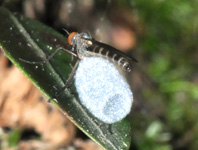Abstract
The first detailed systematic study on the tanytarsine chironomids recorded in the Eocene amber from the Rovno region (Ukraine) revealed seven new taxa. Archistempellina gen. nov., represented by A. bifurca sp. nov. (type for the genus, male) and A. falcifera sp. nov. (male), displays characters similar to those found in Stempellina Thienemann et Bause, and is recognized as one of probable basal lineages in the subtribe Stempellinina Shilova. Corneliola gen. nov., represented by C. avia sp. nov. (male, female), combines features known from several genera of the tribe Tanytarsini, and tentatively is regarded as the closest relative of Constempellina Brundin. Rheotanytarsus alliciens sp. nov. (male), featuring a long hypopygial digitus, is considered to be the oldest species of the genus. Tanytarsus congregabilis sp. nov. (male) is the first known Eocene representative of the lugens systematic species group. A complemented description of the male of Tanytarsus serafini Giłka is provided as well.

